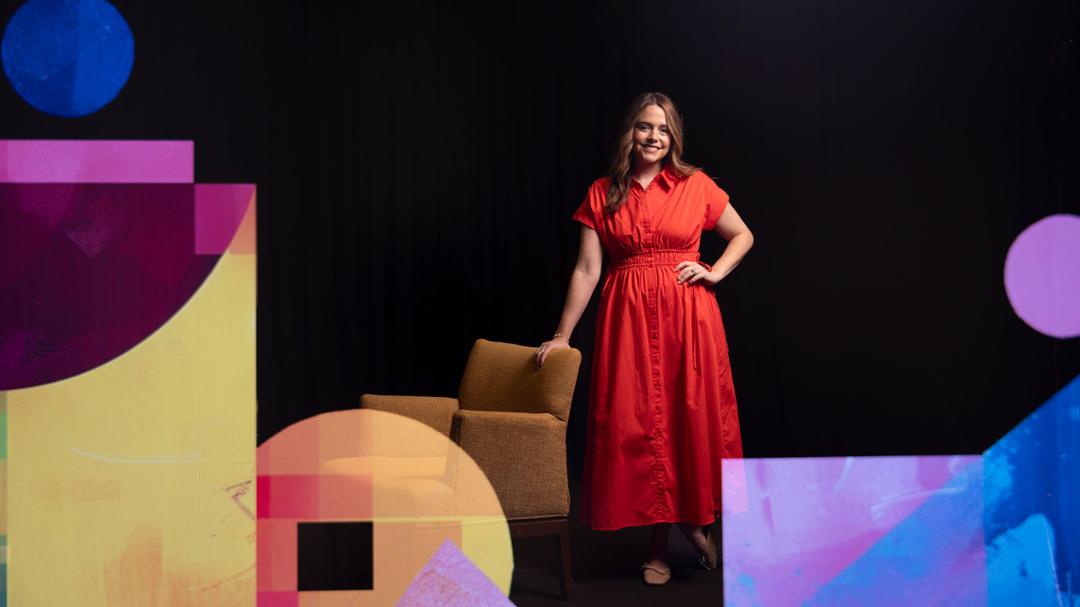Michelle Pearson is at the forefront of the Interior Design program’s work in visualizing a better world for all in the built environment.
Discomfort permeates every corner of a hospital. It looms over waiting rooms like a heavy cloud and swiftly moves through every floor, following the rush of medical personnel from room to room.
Inside a lone room, emotions are heightened. Milliseconds feel like days. All is silent, except for the occasional cough or machine beep.
Oftentimes, those drab rooms do nothing to alleviate the concerns of patients and their loved ones, though they do have the potential to flip attitudes in a positive direction.
Studies show that views of verdant natural landscapes are linked to improved patient outcomes, such as shorter hospital stays, reduced need for pain medication and lower heart rates and blood pressure. But how do health care facilities, especially in arid locations like Lubbock or ones that simply lack those views, provide their patients with those benefits?
Michelle Pearson has sought to answer this question for roughly a decade. The Interior Design associate professor and associate chair of the Department of Design has made significant strides in this quest recently, progressing as she leads the Interior Design program to ever-climbing heights.
“I’m passionate about how the built environment can support healing,” Pearson said. “When patients are going through something traumatic, the space around them should offer comfort, not add to their stress.”
Health Care Design Research
Pearson is West Texas through and through. She grew up in Slaton before coming to Texas Tech University to earn her bachelor’s, master’s and doctoral degrees in interior design, environmental design and interior environmental design, respectively.

Her effort to improve patient outcomes stemmed from the time Pearson spent researching health care environments while studying for her master’s degree in 2013. While learning about different ways to improve the patient experience, she reflected on times she spent in hospitals when she was younger.
During her graduate studies, she conducted a study that added window murals she designed to pediatric patient rooms. The murals brought landscapes and aquatic scenes to window views otherwise displaying adjacent buildings and no nature. She then asked families how they felt about their assigned room and which room they would have preferred.
The children loved the rooms with window murals, especially those that featured fish. Most parents said they favored having any kind of mural as opposed to the dreary standard hospital room, with 95% of respondents indicating they’d prefer a room with murals in the future.
Parents of patients in the control rooms without murals stated their views were depressing and lacked color.
“The control room parents were saying, ‘I just wish we had something to look at. We were in here for days at a time, and it would be nice to have something to enjoy while we are here in the hospital,’” Pearson recalled.

That instance of simple design elements having a large impact stuck with her.
Although pleasing aesthetic sensibilities was important, determining the murals’ physiological impacts was high on her priority list as well.
Pearson’s study found significantly improved blood pressure and heart rate measurements in patients assigned rooms with murals within the first 48 hours of admission. Positive results to be sure, but ones that also revealed several more questions to ask.
Since this initial work, she has conducted several follow-up studies. In 2024, Pearson investigated the effects of 10 varying window mural designs on adolescents in virtual hospital settings.
The WindOvers, as they’re referred to in Pearson’s provisional patent, included themes of abstract art, cultural relevance to Lubbock, aquatic scenes, landscapes and more.
Regardless of the subject matter, the adolescents all preferred the window mural view over that from a nature-less window, and the feedback from patients moved Pearson a step closer to solutions that comfort children during their time in high-stress environments.
The next step is conducting additional research on young adults aged 18- to 22-year-olds, to compare the outcomes of their preferences for window murals to those of adolescents. She will also look at the impact on physiological outcomes, such as blood pressure, heart rate and electroencephalogram brain scan tests, the latter of which measure electrical activity.
With a provisional patent already in hand, Pearson is anticipating collaborating with health care industry entities to enhance patient rooms. She has future plans to expand the applications of the WindOvers to spaces such as waiting rooms, office spaces and oncology units.
In her teenage years, Pearson wouldn’t have predicted the heights she is currently experiencing, either in her own career or while presiding over the Interior Design program.
Progressing the Program
She doesn’t consider her story as one long-destined path to interior design, but rather one composed of key moments that pointed her in that direction.
Other children playing “The Sims,” a popular 2000s video game franchise in which players are interspersed in the everyday lives of characters they created, focused on wardrobes, chatting up a potential suitor or finding a lost cat. Not Pearson.
“I didn’t care about the game itself,” she said. “I just wanted to build the houses.”
In high school, she was drawn to art, specifically painting, and had an impactful art teacher who encouraged her to consider art as a career. But after graduating high school, Pearson still needed to select her major at Texas Tech, which had emerged in her selection process for its culture, size and energy.
Architecture and graphic design remained considerations alongside interior design, but the memories of walking the halls of the College of Health & Human Sciences, where her mother used to work, and seeing the interior design projects on the walls tipped the scales.
A fateful conversation with the Interior Design program director sealed the deal. Pearson ascertained that the program blended all her interests and she would be properly supported, and she appreciated the time program personnel spent listening to and answering her questions.
Pearson’s time as an undergraduate included visits to St. Jude Children’s Research Hospital in Memphis, Tennessee, which revealed in her a desire to help children while they’re undergoing hospital treatment.
“It is so thoughtfully designed, and it’s truly designed for the children, not for adults,” Pearson reflected. “I think that’s what’s really special about that hospital.”
Pearson also spent time working on health care projects for design firm HKS’ Dallas site as part of her required internship.
Those experiences are what the interior design program emphasizes, Pearson says, opportunities to expose students to varied environments in education, health care, hospitality and more.
What Pearson appreciates about interior design, and what most people don’t associate with the practice, is its marriage of art and science. The interior design program teaches students to explore both their creative and evidence-based thinking.
“We have some who maybe lean more to one side or the other, but you really have to be able to be technical and understand codes and health, safety and welfare, while also creating functional, aesthetically pleasing spaces,” Pearson said.
Dispelling narratives that the field does more than select fabric swatches and paint colors is not only beneficial to students; it assuages parents’ concerns as well to know the impacts air quality, lighting and views have on the human mind, body and behavior, and thus, the opportunities present for their children to improve people’s well-being.
Pearson has seen and been inspired by the fruits of these conversations. She’s met and taught many a rising high school senior and first-year undergraduate, then watched them blossom throughout the years they spend at Texas Tech, finding their passion and transforming into young professionals.
Some students have had Pearson right by their side while their eyes are opened to new experiences and possibilities, as she’s led trips to Washington, D.C., Italy and Malawi, among other excursions.
Graduates from the program have landed positions designing commercial interiors, health care facilities, high-end residences, private airplanes, U.S. embassies, in the White House and more.
The skills they learn at Texas Tech do more than provide pathways to enlightening experiences and make things beautiful.
“It’s also about how we impact human beings and the human experience, which is so relevant to the College of Health & Human Sciences,” Pearson said. “We’re all about how we can improve and enhance the human condition.”
The program has evolved substantially since she became a full-time faculty member in 2014. Each year’s new crop of portfolio work somehow surpasses the prior selection, underlining Pearson’s observation that students are improving year after year.
That progress has led to an influx of talented incoming students who are now seeing more unique courses running the gamut of creativity, collaboration and technicality. Though the student population has grown 30% in Pearson’s time there, the level of mentorship between students and faculty and close-knit nature is remarkable.
The result of these developments is an industry-wide reputation and desire to hire the outstanding entry-level designers Texas Tech produces, setting them up for an ascending career trajectory like Pearson has experienced.
“There’s nothing we cannot do from inside of this university,” she said. “I’ve looked back at my own journey and I look at the journeys of my students, and I get inspired when I think about all we’ve done and all we will do in the years to come.”

